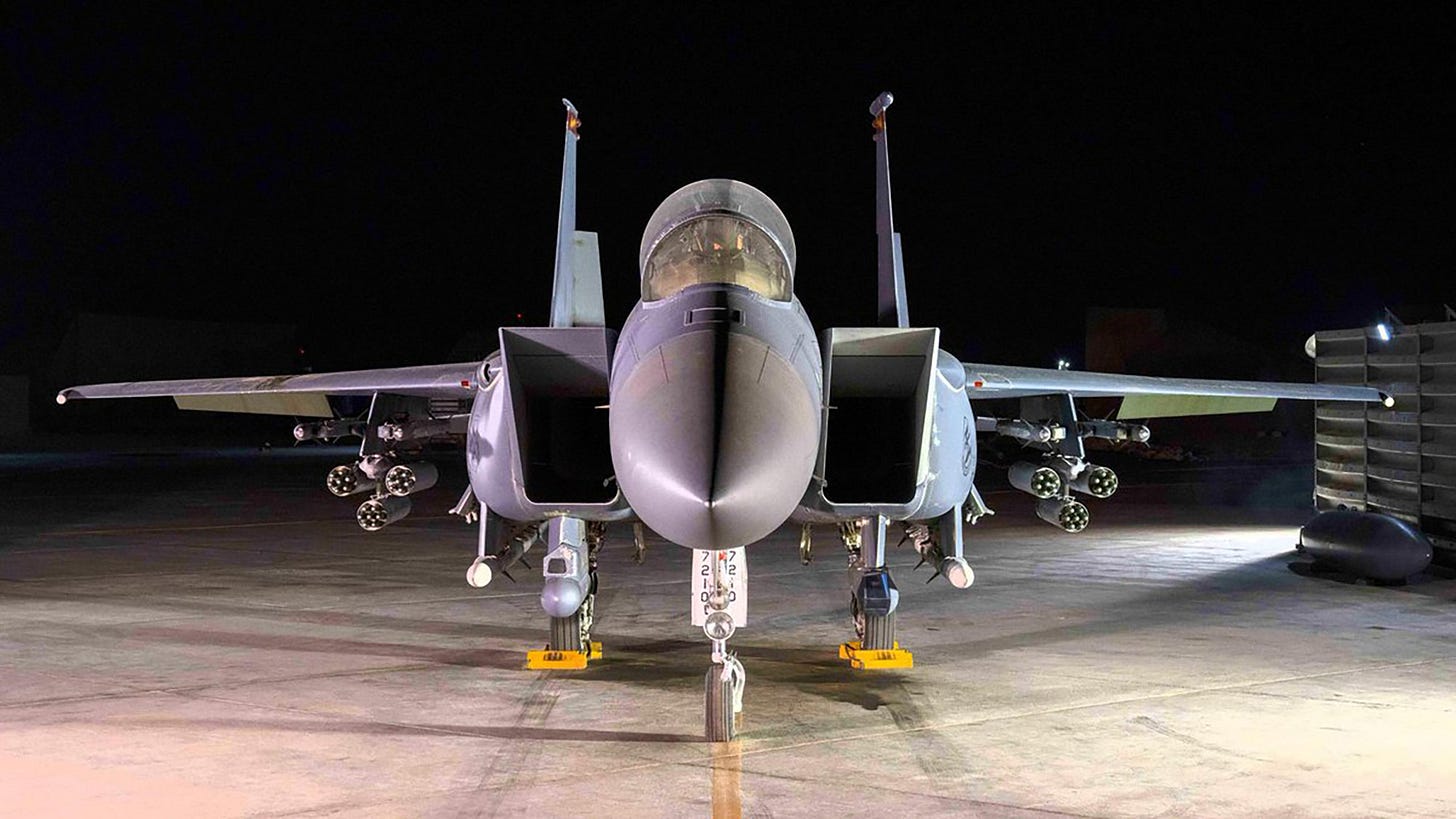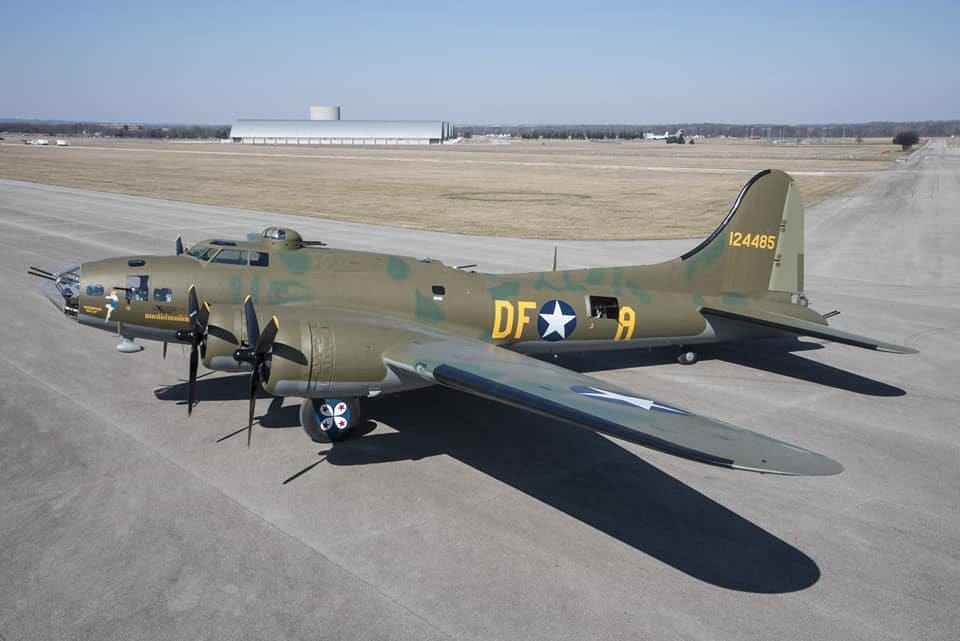The Eagle Flys Again - as a counter to drones
A new way to counter a new threat and remembering the Memphis Belle
"Fighter pilots make movies. Bomber pilots make history."
— General Curtis E. LeMay, U.S. Air Force
Mission Briefing
Strike Eagles Supercharge Counter-Drone Arsenal with APKWS Rockets
By the time the F-15 is fully retired, it may go down as the best fighter - ever. With an already 50-year career - the Eagle keeps adding arrows to its quiver of accomplishments. A recent image released by U.S. Central Command confirms what military aviation watchers had already begun to suspect: the F-15E Strike Eagle has entered the drone-hunting game with a powerful new loadout. Photographed at an undisclosed location in the CENTCOM area of responsibility, this operational Strike Eagle carries six LAU-131A/A rocket pods—each loaded with seven laser-guided AGR-20 APKWS II rockets—for a total of 42 precision-guided munitions dedicated to knocking drones out of the sky.
This loadout isn’t just experimental—it’s combat ready. The same configuration was recently seen at Eglin Air Force Base during testing, and its arrival in theater marks a significant leap in the U.S. Air Force’s ability to counter swarming unmanned threats. In addition to the APKWS rockets, the Strike Eagle pictured also bristled with four AIM-9X Sidewinders and four AIM-120C/D AMRAAMs, giving it a total of 50 potential air-to-air engagements—even before counting the internal cannon.
From Ground Support to Sky Sniper
The APKWS II (Advanced Precision Kill Weapon System) started its life as a low-cost, laser-guided upgrade to the venerable Hydra 70 rocket for ground attack missions. But combat requirements around the globe—especially the rising threat of drone swarms—have driven the U.S. military to adapt the system for air-to-air use.
Fielded across a wide range of platforms from A-10s and F-16s to AH-64 Apaches and Navy helicopters, APKWS has proven to be a flexible and economical precision weapon. The laser-guided system inserts a seeker section between the rocket motor and warhead, using a Distributed Aperture Semi-Active Laser Seeker (DASALS) to home in on illuminated targets. The AGR-20 rockets used by the Strike Eagle are believed to be the upgraded FALCO variant, specifically tailored for air-launched, counter-UAS operations.
Compared to traditional air-to-air missiles, APKWS rockets cost just a fraction—about $30,000 per shot, versus roughly $450,000 for an AIM-9X and over $1 million for an AIM-120. That cost-efficiency enables aircraft like the F-15E to engage a much higher number of low-cost aerial threats without draining expensive missile inventories.
Teamwork Not Required
Where F-16s conducting drone intercepts over the Red Sea typically operate in pairs—one jet to designate the target, the other to fire—F-15Es can do it all solo. Thanks to its two-seat cockpit, the Strike Eagle allows the Weapon Systems Officer (WSO) in the back to handle targeting via the Sniper Advanced Targeting Pod while the pilot flies the intercept. That autonomy allows for more flexible and sustained operations, especially in regions where unmanned threats are constant.
A Response to Real-World Need
The April 2024 Iranian drone attack on Israel highlighted a critical shortcoming in conventional air defense: even the most capable jets can be overwhelmed by sheer volume. Strike Eagles played a key role in intercepting those threats, but each aircraft could only carry a limited number of missiles. This new APKWS loadout addresses that vulnerability directly, massively increasing engagement capacity without sacrificing other mission roles.
The Future of Affordable Air Superiority
BAE Systems continues to improve the APKWS II system with the addition of an infrared seeker, transforming the rocket into a dual-mode weapon. Combined with the FALCO software upgrade, this makes the APKWS a more versatile tool against a broader range of airborne threats, including those that cannot be easily illuminated by laser.
In a world where $2,000 drones can threaten billion-dollar assets, the U.S. Air Force is making a clear shift toward quantity with quality. The integration of APKWS on the Strike Eagle is more than just a cost-saving measure—it’s a smart evolution in air combat that gives American forces more shots, more flexibility, and more time on station. And in a battlespace where seconds count and threats can come in waves, that makes all the difference.
This Week in Aviation History
9 June 1943: Eighty-one years ago this week, one of the most iconic aircraft of World War II completed its mission—not in combat, but in making history. On June 9, 1943, the Memphis Belle, a B-17F Flying Fortress of the U.S. Army Air Forces, was flown back to the United States after completing 25 combat missions over Nazi-occupied Europe. At a time when the average bomber crew faced grim odds, surviving a full tour of duty was rare. Belle and her crew not only made it—they became legends.

A Fortress Against the Odds
Flying out of RAF Bassingbourn in Cambridgeshire, England, and assigned to the 91st Bombardment Group, 324th Bomb Squadron, the Memphis Belle had seen it all: flak-filled skies, enemy fighters, and the brutal reality of daylight strategic bombing. The aircraft, serial number 41-24485, was only the second B-17 to complete 25 missions with its crew intact, earning it a ticket home while many others never returned.
The name Memphis Belle was a tribute to pilot Captain Robert K. Morgan’s girlfriend, Margaret Polk, of Memphis, Tennessee. A "Petty Girl" nose art pin-up, inspired by the work of Esquire artist George Petty, was painted on the bomber’s fuselage and became an enduring symbol of WWII aviation.
The Mission Continues at Home
Upon return to the U.S., the Memphis Belle and her crew were given a new assignment: boost morale and sell war bonds. They became the focus of a 1944 documentary titled “Memphis Belle: A Story of a Flying Fortress”, directed by acclaimed filmmaker William Wyler. The film featured actual combat footage and was selected for preservation by the Library of Congress for its cultural and historical significance.
Postwar Neglect and Ultimate Redemption
Following the war, the Memphis Belle was destined for the scrapyard in Altus, Oklahoma—until a Memphis reporter alerted the city’s mayor. Purchased for its scrap value, the bomber was placed on display in Memphis, but decades of exposure and neglect took a toll.
Eventually, the U.S. Air Force reclaimed the aircraft and began an exhaustive restoration at the National Museum of the U.S. Air Force at Wright-Patterson AFB. On May 17, 2018, a fully restored Memphis Belle went on permanent public display—reborn as a testament to the bravery of the men who flew her and the nation that built her.
The Aircraft Behind the Legend
The B-17F Flying Fortress was a marvel of wartime engineering. Powered by four supercharged Wright R-1820-65 Cyclone radial engines, the aircraft could reach 325 mph at altitude with war emergency power, had a ceiling of 37,500 feet, and a range of over 3,000 miles. Its defensive armament included 13 .50-caliber Browning machine guns, and it typically carried between 4,000–6,000 pounds of bombs on long-range missions.
Out of over 12,700 B-17s built during the war, only three B-17F models survive today. The Memphis Belle stands among them—not just as a preserved airframe, but as a living story of courage, loss, and resilience.
“The Memphis Belle isn’t just a plane. She’s a reminder—of the risks, the sacrifices, and the unbreakable bond between a crew and their aircraft.”
In Case You Missed It
All about the best helicopter to never make it into production:
Photo Outlet
Every issue of Hangar Flying with Tog gets you a free image that I’ve taken at airshows - and this week I wanted to change it up by including a brief video:
Feel free to use these photos (or in this case video) however you like, if you choose to tag me, I am @pilotphotog on all social platforms. Thanks!
Post Flight Debrief
Like what you’re reading? Stay in the loop by signing up below—it’s quick, easy, and always free.
This newsletter will always be free for everyone, but if you want to go further, support the mission, and unlock bonus content, consider becoming a paid subscriber.
Your support keeps this flight crew flying—and I couldn’t do it without you.
– Tog





